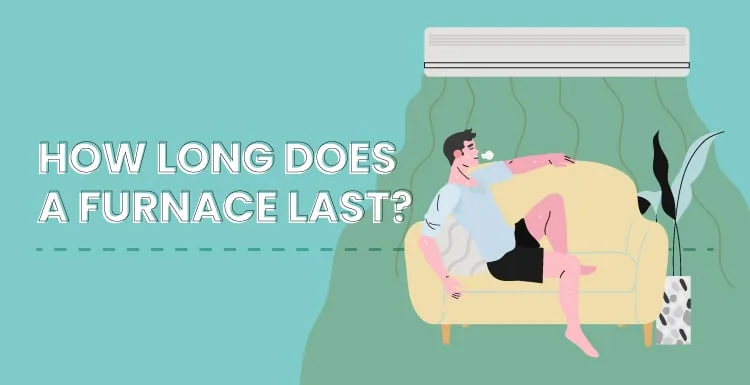On average, how long does a furnace last? Is there a standard amount of time a furnace should last before it needs to be replaced or repaired? How do you know when it’s time to replace one?
These are common questions for homeowners. Knowing how long your furnace will work without issues is important. After all, you don’t want to be surprised by huge out-of-pocket expenses.
Furnaces vary greatly in quality. But, in general, most furnaces will last more than a decade—sometimes two. Beyond that, you may start noticing problems with the unit’s operation and efficiency.
Parts will deteriorate and break. In this guide, we’ll discuss factors affecting how long a furnace lasts, buying considerations, maintenance tips, and signs that your furnace may need to be replaced.
How Long Does a Furnace Last?
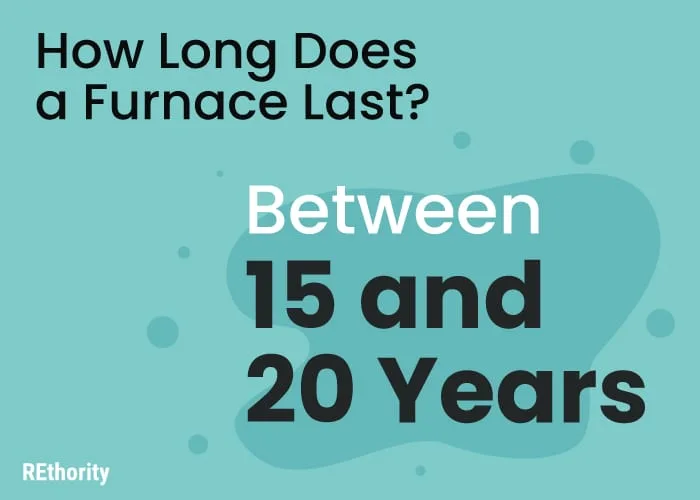
So, how long does a furnace last? The short answer is between 15 and 20 years. However, different factors may increase or decrease the average lifespan.
The average furnace usage, location, quality of installation, maintenance schedule, size, brand, and type of furnace all affect how long a furnace will last.
If you have an older forced-air furnace with cast iron heat exchangers and burners, it could last up to 40 years. These older furnaces are less efficient, but their components and setup mean they’ll last longer.
Here’s the relative lifespan of a furnace by type:
- Electric furnace or active solar heating system: Lasts 20+ years
- Older forced-air furnace with cast iron heat exchangers: Lasts 30–40 years
- Gas furnaces and boilers: last 15–30 years
- Heat pumps: Lasts ~15 years
How to Determine How Old a Furnace Is
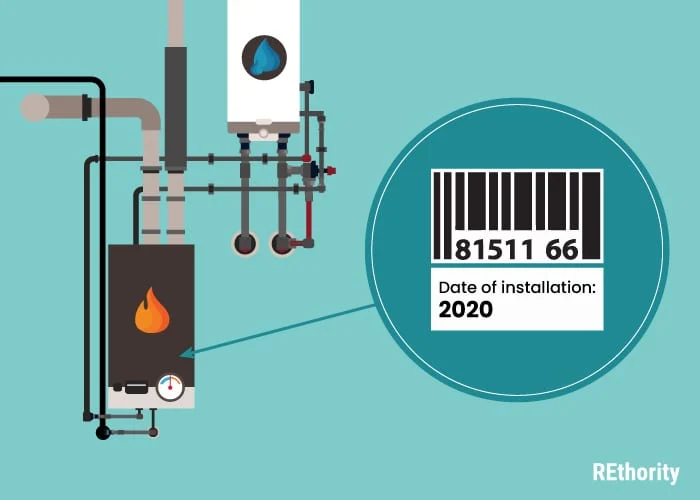
If you’ve moved into a house or just don’t know how old your furnace is, it’s easy to find out. Every furnace manufacturer includes a serial number on the unit.
It’s usually located inside the furnace cover. Take a peek inside the cover to find the serial number, then contact your heating and cooling company to have them look up the date of manufacture.
Furnaces that are 15+ years old and have been used heavily or in very cold climates may be ready or near-ready for replacement.
Your heating and cooling professional will advise you if it’s time to replace it or if there is still plenty of life left.
Factors That Affect a Furnace Lifespan
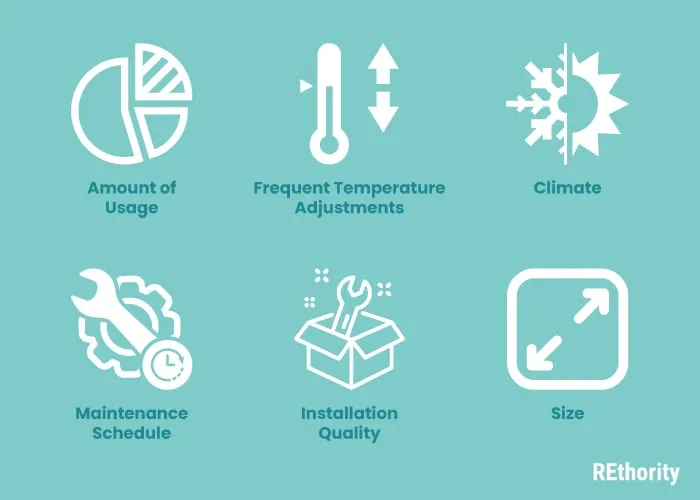
1. Amount of Usage
How much a furnace is used factors into its overall lifespan. The more a furnace is used, the faster the internal components wear out.
Typically, furnaces are used more in very cold climates and may not last as long under these high-use conditions.
However, the opposite can also be true. If a furnace has been sitting unused for an extended period of time—a year or more—it can affect its lifespan as well.
Long periods of dormancy can cause internal components to go bad and result in the need for replacement parts sooner than normal.
2. Size
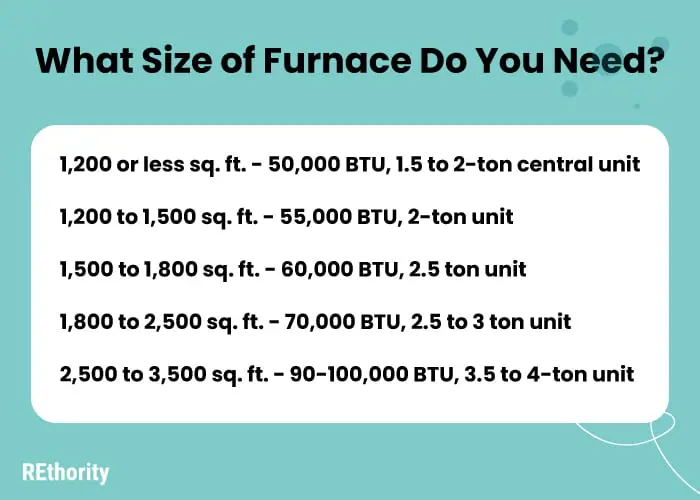
The size of your furnace compared to your home’s size is an important factor in its lifespan. One that is too small will have to work overtime to keep your home heated.
One that is too large will run shorter cycles, which will make it cycle on and off too frequently. An HVAC professional can recommend the proper furnace size and heat output for your home.
Here are a few general recommendations:
- A 1,200 or less sq. ft. home needs 50,000 BTU from a 1.5 to 2-ton central unit.
- A 1,200 to 1,500 sq. ft. home needs 55,000 BTU from a 2-ton unit.
- A 1,500 to 1,800 sq. ft. home needs 60,000 BTU from a 2.5 ton unit.
- A 1,800 to 2,500 sq. ft. home needs 70,000 BTU from a 2.5 to 3 ton unit.
- A 2,500 to 3,500 sq. ft. home needs 90-100,000 BTU from a 3.5 to 4-ton unit.
3. Climate
Colder climates are hard on furnaces. They have to run more often and work harder to heat indoor spaces when it’s very cold outside.
Heat also dissipates faster in very cold climates, so once the air inside is finally warm, the furnace has to keep working, cycling on and off, to ensure it stays that way.
This puts a lot of stress on the internal components and causes the furnace’s lifespan to shorten overall. Frequent power outages in very cold weather can also cause problems for a furnace’s longevity.
After a period of no power, the air inside the home will be very cold. The furnace will have to work much harder to “catch up” and heat the home from a starting point that could be below freezing temperatures.
4. Maintenance Schedule
Lack of routine maintenance is another lifespan detractor for furnaces (or any heating and cooling equipment, for that matter). Well-maintained furnaces last longer with fewer issues than furnaces that are rarely or never maintained on a schedule.
Your entire HVAC system should be inspected once or twice a year by professionals, and regular maintenance is a necessity, not a bonus.
Here’s what you can do to keep your furnace well maintained and increase its lifespan:
- Change the filter regularly (1-2” filters every three months; 4” filters every six months; 5” filters every 12 months)
- Keep the drainage tube (for gas and propane furnaces) clean and free of debris or sludge
- Vacuum and dust regularly to keep the furnace filter from becoming dirty too quickly
- Run the furnace at comfortable temperatures and don’t manually adjust the thermostat often
- Have your furnace inspected at the start of the cold season to ensure everything is working properly
5. Brand
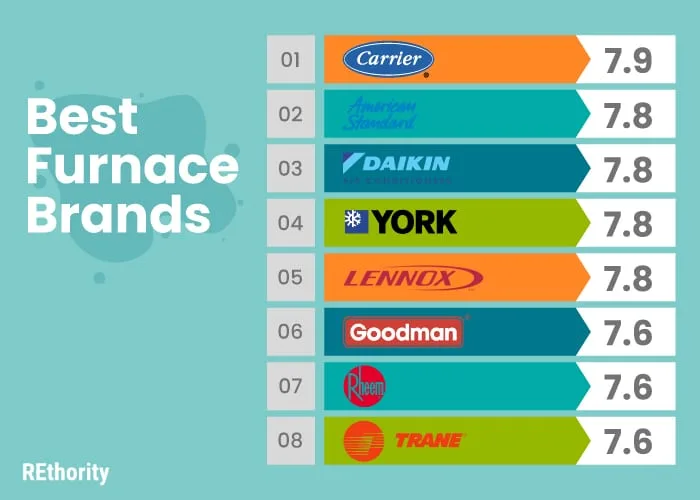
The brand of furnace you choose has a lot to do with how long it will last. Quality brands that have been around for a long time and get good reviews are your best bet.
Here’s a list of the top 8 furnace brands that have the best overall ratings, according to Modernize. These ratings take price, energy efficiency, quality, customer service, warranty, and financing options into account.
- Carrier: 7.9
- American Standard: 7.8
- Daikin: 7.8
- York: 7.8
- Lennox: 7.8
- Goodman: 7.6
- Rheem: 7.6
- Trane: 7.6
As you can see, Carrier has the best overall rating from this study. The only thing that brought Carrier’s score down a bit was the overall pricing.
But because their furnaces are high quality and seem to last longer, the price difference from low-end brands could be more than worth it.
6. Installation Quality
Proper installation is key to a long furnace’s lifespan. Improper installation can hamper the furnace’s efforts from the start and result in damaged or broken parts, lackluster performance, and overworked components that give out sooner.
Make sure your furnace is installed and inspected by a professional. If you’ve had the wrong size, design, or improperly sealed ductwork installed, your furnace will work overtime to heat your home while blowing wasted warm air through openings in the ductwork.
That drives your energy bill up and overworks your system. High-efficiency furnaces need a good drainage system to keep up with the water created as a byproduct of operation.
If the drainage system isn’t adequate, backed-up water can damage the flame sensor. And improperly installed fuel lines or exhaust ventilation create serious safety hazards that can’t be risked.
Always have a professional do installations. We’ll say that again: Always have a professional install your furnace. Doing it yourself can cause you severe headaches and even death.
7. Frequent Temperature Adjustments
Some people operate their furnace in a very hands-on manner, turning the temperature up high to start, then lowering it as the house’s temperature becomes comfortable.
This type of operation, with frequent temperature adjustments, affects the overall lifespan of the furnace.
Manual temperature adjustments wear out the internal components faster. It can also overheat the furnace and even melt some of the components.
The better option is setting a temperature and letting the furnace cycle through to reach a comfortable temperature (best is 60 degrees to 80 degrees) in your home. Don’t manually adjust the temperatures often.
Signs a Furnace Needs to be Replaced
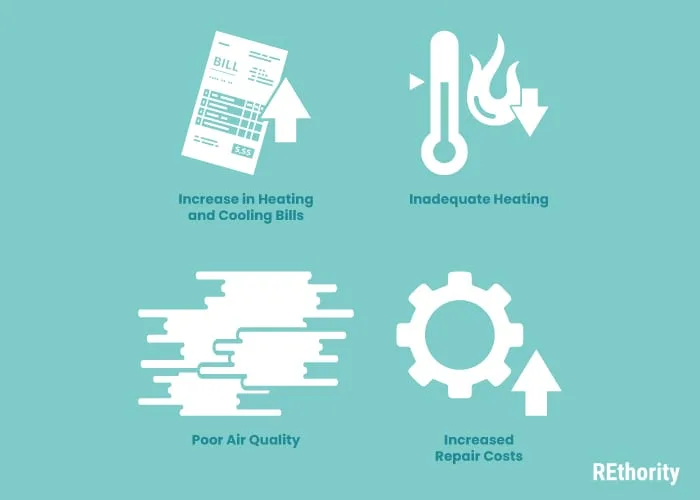
With these factors in mind, you may be realizing that your furnace has been used a lot, is working against a very cold climate, hasn’t been maintained properly, or isn’t the right size for your home
How much longer might your furnace last? There are a few telltale signs that a furnace needs to be replaced soon.
Be on the lookout for any of these signs:
- Sharp spike in heating and cooling bills: If your heating and cooling costs have recently taken a sharp turn upward during the colder months of the year, your furnace is the likely culprit. If it’s close to 15 years old (or older), this might be a signal that it’s working overtime to keep up with even a normal heating demand. And if that’s the case, it may not be much longer before it gives out altogether.
- Inadequate heating: If your thermostat is set to your usual temperatures and you can hear the system working and on but not putting out adequate heat, it might be a sign that your furnace is on its last leg. Inadequate heating is a common sign that a furnace is close to breaking down. You may be able to have an HVAC professional replace a part to fix the problem temporarily, but there’s a good chance another part will go out soon after that.
- Inferior air quality inside the home: If you’ve noticed the air quality suffering inside your home, an old furnace could be to blame. Noticing more allergy symptoms, cracks in furniture, static shocks, or even unhealthy houseplants can indicate poor air quality. Aging furnaces contribute to poor air quality with dirty filters, a decreased ability to add moisture to the air, and clean particles from the air.
- Increased repairs and part replacements: If you’ve been spending more to replace parts and have made more calls to your HVAC professional for repairs on your furnace lately (and it’s about 15 years old), it’s a good indicator that it’s on the way out. Consult your HVAC professional for recommendations on choosing a replacement.
So, How Long Does a Furnace Last?
Your furnace is an essential component of your HVAC system. Designed to keep your home toasty and comfortably warm during the colder months, it does an important job.
But furnaces don’t last forever. You can expect your furnace to last for anywhere from 15 to 40 years, depending on the type of furnace, your climate, the installation quality, and how you use it.
Add years to your furnace’s lifespan by:
- Keeping up with regular maintenance and inspections
- Limiting manual thermostat adjustments
- Keeping your home free from excessive dust and dirt
- And ensuring you’re using the right size furnace for your home
Working with a trusted HVAC professional can ensure you keep your furnace in top-notch condition for as long as possible.

